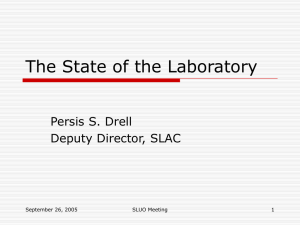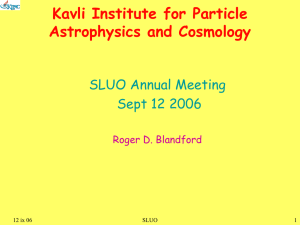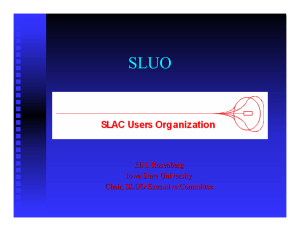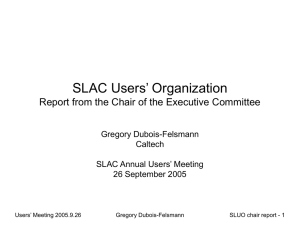The International Linear Collider Barry Barish Caltech 2006 SLUO Annual Meeting
advertisement
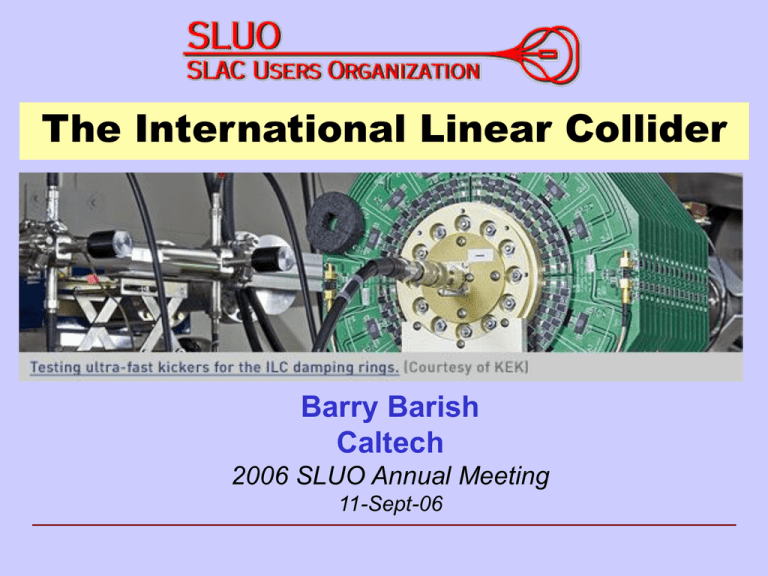
The International Linear Collider Barry Barish Caltech 2006 SLUO Annual Meeting 11-Sept-06 Why e+e- Collisions ? • elementary particles • well-defined – energy, – angular momentum • uses full COM energy • produces particles democratically • can mostly fully reconstruct events 11-Sept-06 SLUO Annual Meeting 2 Electron Positron Colliders The Energy Frontier 11-Sept-06 SLUO Annual Meeting 3 How do you know you have discovered the Higgs ? Measure the quantum numbers. The Higgs must have spin zero ! The linear collider will measure the spin of any Higgs it can produce by measuring the energy dependence from threshold 11-Sept-06 SLUO Annual Meeting 4 Direct production from extra dimensions ? Linear collider New space-time dimensions can be mapped by studying the emission of gravitons into the extra dimensions, together with a photon or jets emitted into the normal dimensions. 11-Sept-06 SLUO Annual Meeting 5 The ILC measures coupling strength of the Higgs with other particles Higgs Coupling-mass relation mi v i 11-Sept-06 SLUO Annual Meeting 6 What can we learn from the Higgs? Precision measurements of Higgs coupling can reveal extra dimensions in nature •Straight blue line gives the standard model predictions. • Range of predictions in models with extra dimensions -yellow band, (at most 30% below the Standard Model • The red error bars indicate the level of precision attainable at the ILC for each particle 11-Sept-06 SLUO Annual Meeting 7 Supersymmetry Supersymmetric Partner u c t g H d s b g H ne nm nt W e m t Z Spin 1/2 11-Sept-06 ~ g ~ H ~ b ~ ~ ~ g H s ~ ~ ne ~ nt W nm ~ ~ ~ e ~ Z m ~ t Spin Spin 0 1 SLUO Annual Meeting ~ u ~ d ~ t~ c Spin 0 Spin Spin 1/2 1/2 8 GLC GLC/NLC Concept • The JLC-X and NLC essentially a unified single design with common parameters • The main linacs based on 11.4 GHz, room temperature copper technology. 11-Sept-06 SLUO Annual Meeting 9 TESLA Concept • The main linacs based on 1.3 GHz superconducting technology operating at 2 K. • The cryoplant, is of a size comparable to that of the LHC, consisting of seven subsystems strung along the machines every 5 km. 11-Sept-06 SLUO Annual Meeting 10 The ITRP Recommendation • We recommend that the linear collider be based on superconducting rf technology – This recommendation is made with the understanding that we are recommending a technology, not a design. We expect the final design to be developed by a team drawn from the combined warm and cold linear collider communities, taking full advantage of the experience and expertise of both (from the Executive Summary). 11-Sept-06 SLUO Annual Meeting 11 SCRF Technology Recommendation • The recommendation of ITRP was presented to ILCSC & ICFA on August 19, 2004 in a joint meeting in Beijing. • ICFA unanimously endorsed the ITRP’s recommendation on August 20, 2004 11-Sept-06 SLUO Annual Meeting 12 Parameters for the ILC • Ecm adjustable from 200 – 500 GeV • Luminosity ∫Ldt = 500 fb-1 in 4 years • Ability to scan between 200 and 500 GeV • Energy stability and precision below 0.1% • Electron polarization of at least 80% • The machine must be upgradeable to 1 TeV 11-Sept-06 SLUO Annual Meeting 13 Global Effort on Design / R&D for ILC EU Snowmass 49 GDE members --------Present GDE Membership Americas 22 Europe 24 Asia Asia 18 US 2003年 7月 About 30 FTEs Joint Design, Implementation, Operations, Management Host Country Provides Conventional Facilities 11-Sept-06 SLUO Annual Meeting 14 Global Design Effort – The Mission of the GDE • Produce a design for the ILC that includes a detailed design concept, performance assessments, reliable international costing, an industrialization plan , siting analysis, as well as detector concepts and scope. • Coordinate worldwide prioritized proposal driven R & D efforts (to demonstrate and improve the performance, reduce the costs, attain the required reliability, etc.) 11-Sept-06 SLUO Annual Meeting 15 Designing a Linear Collider pre-accelerator few GeV source KeV damping ring few GeV few GeV bunch compressor 250-500 GeV main linac extraction & dump final focus IP collimation Superconducting RF Main Linac 11-Sept-06 SLUO Annual Meeting 16 Parametric Approach • A working space - optimize machine for cost/performance 11-Sept-06 SLUO Annual Meeting 17 The Key Decisions Critical choices: luminosity parameters & gradient 11-Sept-06 SLUO Annual Meeting 18 Making Choices – The Tradeoffs Many decisions are interrelated and require input from several WG/GG groups 11-Sept-06 SLUO Annual Meeting 19 Superconducting RF Cavities High Gradient Accelerator 35 MV/meter -- 40 km linear collider 11-Sept-06 SLUO Annual Meeting 20 single-cell measurements (in nine-cell cavities) Gradient Results from KEK-DESY collaboration must reduce spread (need more statistics) 11-Sept-06 SLUO Annual Meeting 21 Baseline Gradient 11-Sept-06 SLUO Annual Meeting 22 SRF Cavity Gradient Cavity type initial upgrade Qualified gradient Operational gradient Length* energy MV/m MV/m Km GeV TESLA 35 31.5 10.6 250 LL 40 36.0 +9.3 500 Total length of one 500 GeV linac 20km 11-Sept-06 SLUO Annual Meeting * assuming 75% fill factor 23 The Baseline Machine (500GeV) ~31 km 20mr ML ~10km (G = 31.5MV/m) RTML ~1.6km 2mr R = 955m E = 5 GeV BDS 5km e+ undulator @ 150 GeV (~1.2km) x2 not to scale 11-Sept-06 SLUO Annual Meeting 24 From Baseline to a RDR July Jan Frascati 2006 Bangalore Vancouver Dec Valencia Freeze Configuration Organize for RDR Review Design/Cost Methodology Review Initial Design / Cost Design and Costing 11-Sept-06 SLUO Annual Meeting Review Final Design / Cost RDR Document Preliminary RDR Released 25 The Main Linac Configuration • Klystron – 10 MW (alternative sheet beam klystron) • RF Configuration – 3 Cryomodules, each with 8 cavities • Quads – one every 24 cavities is enough 11-Sept-06 SLUO Annual Meeting 26 ILC Cryomodule Increase diameter beyond X-FEL Increase diameter beyond X-FEL Review 2-phase pipe size and effect of slope 11-Sept-06 SLUO Annual Meeting 27 RF Power: Baseline Klystrons Specification: 10MW MBK 1.5ms pulse 65% efficiency Thales 11-Sept-06 CPI Toshiba SLUO Annual Meeting 28 Linear Collider Facility Main Research Center Particle Detector ~30 km long tunnel Two tunnels • accelerator units • other for services - RF power 11-Sept-06 SLUO Annual Meeting 29 Reference Design – Regional Differences Tunnel Diameter • Both tunnels are 5 meter diameter (Fixed) • 5 meters in Asia & 7.5 meters elsewhere between tunnels (for structural reasons) • 5 meters between tunnels required for shielding 11-Sept-06 SLUO Annual Meeting 30 Baseline Features – Electron Source • Electron Source – Conventional Source using a DC ----- Titanium-sapphire laser emits 2-ns pulses that knock out electrons; electric field focuses each bunch into a 250-meter-long linear accelerator that accelerates up to 5 GeV 11-Sept-06 SLUO Annual Meeting 31 Baseline Features – Positron Source • Positron Source – Helical Undulator with Polarized beams – 150 Gev electron beam goes through Primary esource a 200m undulator ing making photons that hit a 0.5 rl titanium alloy target to produce positrons. The positrons are accelerated to 5-GeV accelerator before injecting into positron damping ring. Beam Delivery System eDR 150 GeV 100 GeV Helical Undulator In By-Pass Line Photon Collimators Positron Linac IP 250 GeV e+ DR Target eDump Photon Beam Dump Auxiliary eSource 11-Sept-06 Photon Target Adiabatic Matching Device SLUO Annual Meeting e+ preaccelerator ~5GeV 32 6 Km Damping Ring 6km Requires Fast Kicker 5 nsec rise and 30 nsec fall time The damping rings have more accelerator physics than the rest of the collider 11-Sept-06 SLUO Annual Meeting 33 Beam Delivery System Baseline • Requirements: – – – – Focus beams down to very small spot sizes Collect out-going disrupted beam and transport to the dump Collimate the incoming beams to limit beam halo Provide diagnostics and optimize the system and determine the luminosity spectrum for the detector – Switch between IPs 11-Sept-06 SLUO Annual Meeting 34 Cost vs Performance • We obtained our first ILC costing in July • We are validating those costs and studying areas where different costing disagree • We are studying areas where costs appear larger than expected for requirements, value engineering, etc. • Our aim is to produce a reference design, which has taken into account major cost vs performance optimization – examples – – – – 11-Sept-06 2mr x 20 mr compared to 14mr x 14 mr One positron damping ring Optimizing size of tunnels Position of damping ring SLUO Annual Meeting 35 Final Remarks • Design Status and Plans – Baseline was determined and documented at end of 2005 – Plan to complete reference design / cost by the end of 2006 – Technical design by end of 2009 • R & D Program – Support baseline: demonstrations; optimize cost / perfomance; industrialization – Develop improvements to baseline – cavities; high power RF • Overall Strategy – Be ready for an informed decision by 2010 – Siting; International Management; LHC results; CLIC feasibility etc 11-Sept-06 SLUO Annual Meeting 36
